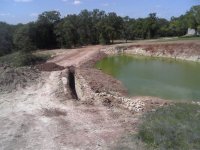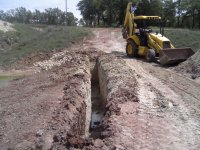jinman
Rest in Peace
- Joined
- Feb 23, 2001
- Messages
- 21,059
- Location
- Texas - Wise County - Sunset
- Tractor
- NHTC45D, NH LB75B, Ford Jubilee
Baby birds go, "Peep! Peep! Peep!," and baby ponds go, "Seep! Seep! Seep!.":confused2:
As Ron Hall and I discovered while he was here, my little pond is still seeping very slowly through the sand layer in the native soil. My wife calls it a "sand pipe." I'd be golden if the 1' layer of sand was not between the clay and hard caliche. Unfortunately, I've slowed the seep speed by putting clay down next to the dam, but it hasn't stopped. Over 1 week, my pond level has dropped about 3" due to the seep. If I had known the sand layer would be a problem, I would have put a key trench down past the sand level when I was building the rest of the dam, but all is not lost. I can still put in a core trench of sorts. Yesterday, I decided to dig a 2' wide trench down below the level of the sand pipe and then fill and compact with clay using the backhoe.
The first photo shows the completed trench. On the right, you can see all the clay I added to the edge of the water to slow the seep. That slowed the seep tremendously, but not completely. I started my trench in the solid clay dam and continued until I got to the clay at the overflow pipe. As I was digging (down about 5-1/2') I could see the water seeping into the trench. The funny thing is the first seep started on the side of the trench away from the pond. That's because the water was seeping into the sand layer and then spreading out like pancake batter on a grill. I kept digging until the water could clearly be seen coming into the trench from the pond side. I continued digging until it quit and also about 1' below the level of the sand.
The second photo shows the trench by the backhoe for size/depth reference. You can see water pooling into the trench.
The final picture is a closeup of the trench. Because the sand is essentially the same gray color as the clay and caliche, you can't easily see the layer. However, when looking into the trench, I could see water running in and the sand sloughing off into the trench.
I didn't get a finished picture, but I put in clay and compacted it in 1' layers. I think I got a nice tight pack and only time will tell if I've slowed the seep or if I need to make a bigger wide trench down the middle of the dam. One way or the other, I'm gonna get 'er done. Bentonite may be in my future if I have to dig another trench. I'll line the bottom of the trench with it before backfill if I have to dig another blocking trench.
BTW: pacerron, I haven't found my round tuit, but I also haven't forgotten about measuring the length of the dam. Perhaps, this weekend with my grandson. . . .
As Ron Hall and I discovered while he was here, my little pond is still seeping very slowly through the sand layer in the native soil. My wife calls it a "sand pipe." I'd be golden if the 1' layer of sand was not between the clay and hard caliche. Unfortunately, I've slowed the seep speed by putting clay down next to the dam, but it hasn't stopped. Over 1 week, my pond level has dropped about 3" due to the seep. If I had known the sand layer would be a problem, I would have put a key trench down past the sand level when I was building the rest of the dam, but all is not lost. I can still put in a core trench of sorts. Yesterday, I decided to dig a 2' wide trench down below the level of the sand pipe and then fill and compact with clay using the backhoe.
The first photo shows the completed trench. On the right, you can see all the clay I added to the edge of the water to slow the seep. That slowed the seep tremendously, but not completely. I started my trench in the solid clay dam and continued until I got to the clay at the overflow pipe. As I was digging (down about 5-1/2') I could see the water seeping into the trench. The funny thing is the first seep started on the side of the trench away from the pond. That's because the water was seeping into the sand layer and then spreading out like pancake batter on a grill. I kept digging until the water could clearly be seen coming into the trench from the pond side. I continued digging until it quit and also about 1' below the level of the sand.
The second photo shows the trench by the backhoe for size/depth reference. You can see water pooling into the trench.
The final picture is a closeup of the trench. Because the sand is essentially the same gray color as the clay and caliche, you can't easily see the layer. However, when looking into the trench, I could see water running in and the sand sloughing off into the trench.
I didn't get a finished picture, but I put in clay and compacted it in 1' layers. I think I got a nice tight pack and only time will tell if I've slowed the seep or if I need to make a bigger wide trench down the middle of the dam. One way or the other, I'm gonna get 'er done. Bentonite may be in my future if I have to dig another trench. I'll line the bottom of the trench with it before backfill if I have to dig another blocking trench.
BTW: pacerron, I haven't found my round tuit, but I also haven't forgotten about measuring the length of the dam. Perhaps, this weekend with my grandson. . . .



